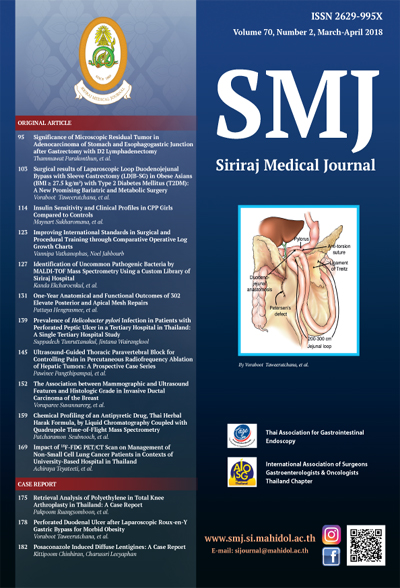Prevalence of Helicobacter pylori Infection in Patients with Perforated Peptic Ulcer in a Tertiary Hospital in Thailand: A Single Tertiary Hospital Study
Abstract
Objective: Because of limited resources, the approach in Thailand is to eradicate Helicobacter pylori (H. Pylori) infection in every patient with peptic ulcer perforation, but without infectious confirmation because of suspected
high infection rates. Only one study reported the incidence of infection in perforated disease in Thailand with limited number of patents. Our aims were to study the prevalence of H. pylori infection in patients with perforation
and to explore associated factors.
Methods: In a total 136 patients, infection was confirmed by rapid urease testing during post-operative esophagogastroduodenoscopy. The statistical analysis were Fisher’s exact test and multiple logistic regression analysis.
Results: The infection rate was 69.6%. Age ≥ 60 years and male were correlated with infection in multivariable analysis (odds ratio: 3.4 and 4.3, p=0.01 and 0.03, respectively). Only age ≥ 60 years was associated with infection
in the univariable analysis (odds ratio: 2.7, p=0.02) with an infection rate of 81.5%. Three upper gastrointestinal cancers were also seen.
Conclusion: The prevalence of Helicobacter pylori infection in perforated peptic ulcer patients in our study was high. Male patients ≥ 60 years of age appeared to be more prone to infection. The non-documented infection
eradication approach may be more justified in older male patients, especially those with multiple comorbidities.
Downloads
Published
How to Cite
Issue
Section
License
Authors who publish with this journal agree to the following conditions:
Copyright Transfer
In submitting a manuscript, the authors acknowledge that the work will become the copyrighted property of Siriraj Medical Journal upon publication.
License
Articles are licensed under a Creative Commons Attribution-NonCommercial-NoDerivatives 4.0 International License (CC BY-NC-ND 4.0). This license allows for the sharing of the work for non-commercial purposes with proper attribution to the authors and the journal. However, it does not permit modifications or the creation of derivative works.
Sharing and Access
Authors are encouraged to share their article on their personal or institutional websites and through other non-commercial platforms. Doing so can increase readership and citations.










